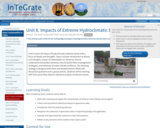
Picture of urban flooding
Provenance: Timothy Swinson https://commons.wikimedia.org/wiki/File:Trapped_woman_on_a_car_roof_during_flash_flooding_in_Toowoomba_2.jpg
Reuse: This item is offered under a Creative Commons Attribution-NonCommercial-ShareAlike license http://creativecommons.org/licenses/by-nc-sa/3.0/ You may reuse this item for non-commercial purposes as long as you provide attribution and offer any derivative works under a similar license.
Unit 8 covers the basics of hydroclimatic extreme events with a focus on floods and droughts. Topics include introduction to floods and droughts, impact of urbanization on extremes, how to understand and predict extremes, how to tackle them (management strategies), and elements of urban climate resilience. The teaching strategy is designed with short and divided lectures filled with discussion questions and a group activity. Students will be working with time series flow data for statistical analysis of extreme events.
(Note: this resource was added to OER Commons as part of a batch upload of over 2,200 records. If you notice an issue with the quality of the metadata, please let us know by using the 'report' button and we will flag it for consideration.)
- Subject:
- Biology
- Career and Technical Education
- Environmental Studies
- Geology
- Life Science
- Mathematics
- Measurement and Data
- Physical Science
- Statistics and Probability
- Material Type:
- Activity/Lab
- Module
- Provider:
- Science Education Resource Center (SERC) at Carleton College
- Provider Set:
- Teach the Earth
- Author:
- Manoj Jha
- Date Added:
- 09/20/2022
